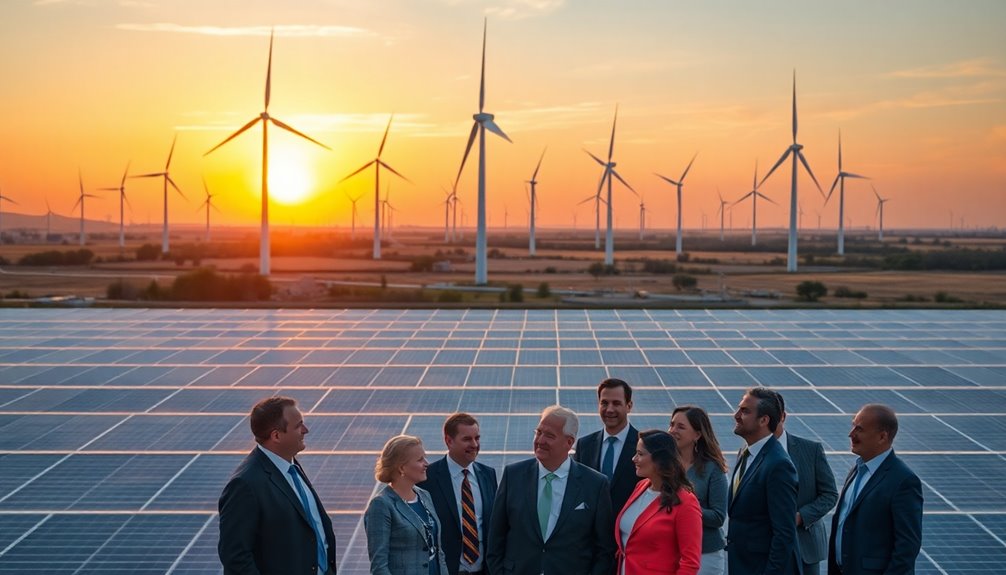If you're looking for the best energy infrastructure private placement deals, focus on recent successes like MN8, which raised $325 million for renewable projects, or Tree Energy Solutions, with $152 million for solar and nuclear ventures. Renewable energy investments surged to $22.9 billion in early 2024, showcasing robust growth in this sector. Look for funds that balance financial leverage with solid management, especially those targeting clean energy transitions. Regulatory frameworks, emerging economies, and public-private partnerships can also influence your investment strategy. There's much more to explore in this evolving landscape, so let's uncover additional insights together.
Key Takeaways
- Focus on renewable energy projects, as they align with decarbonization efforts and are supported by significant government policy initiatives like the Inflation Reduction Act.
- Evaluate private equity firms that employ hedging strategies and modest financial leverage to mitigate risks in volatile energy markets.
- Consider geographic investment insights, particularly in emerging markets like Latin America and the Middle East, to identify lucrative energy infrastructure opportunities.
- Look for collaboration with experienced management teams, as this enhances the development and scalability of energy projects.
- Monitor the increasing institutional investment from pension funds and sovereign wealth funds, which can create stable revenue streams for energy infrastructure deals.
Key Recent Deals Overview

In the dynamic landscape of energy infrastructure, recent deals highlight a surge in investment and strategic growth. For instance, MN8 secured $325 million in April 2024, with contributions from Mercuria Energy Group and Ridgewood Infrastructure. This funding will bolster MN8's expansion plans, aligning with its portfolio of 3.2 GW of renewable energy, which serves over 40 corporations and numerous government entities. Notably, Mercuria and Ridgewood will have board representation, indicating their commitment to MN8's vision.
Another significant development is Tree Energy Solutions' (TES) $152 million raised in a Series C funding round, aimed at advancing global green energy projects, particularly in solar and nuclear energy. This investment reflects the ongoing trend of substantial financial backing for leaders in renewable energy. Furthermore, private equity activity surged, with renewable energy-related deals totaling $22.9 billion in Q2 2024, marking a 316% increase from the previous quarter. This uptick in deal value and the growing focus on decarbonization underscore the sector's resilience and attractiveness to investors, despite economic challenges like high interest rates and inflation. Additionally, the number of deals in Q2 2024 showed a decline, indicating cautious investor behavior amidst these opportunities.
Funding Trends in Renewable Energy

Amidst a rapidly evolving energy landscape, funding trends in renewable energy reveal a robust surge in investment that's reshaping the sector. Global energy investment is set to exceed USD 3 trillion in 2024, with a significant USD 2 trillion earmarked for clean energy technologies and infrastructure.
Emerging economies are seeing clean energy investments approach USD 320 billion, a remarkable 50% increase since 2020.
In the U.S., energy transition financing reached a record USD 303.3 billion in 2023, largely driven by solar capacity additions. States like California and Texas, with ambitious decarbonization goals, are attracting substantial investments. Renewable deployment is projected to grow by 17% to 42 GW in 2024, reflecting the ongoing momentum in the sector.
Technological advancements have also played a role; solar panel costs have dropped by 30%, making renewable investments more attractive.
Policy impacts are crucial as federal initiatives like the Inflation Reduction Act (IRA) and the Infrastructure Investment and Jobs Act (IIJA) fuel this growth.
These policies, along with emissions reduction goals and energy security imperatives, are propelling clean energy spending worldwide.
Performance of Private Equity Involvement

As investment in renewable energy accelerates, private equity involvement is proving to be a significant driver of growth and innovation in the sector.
You'll find that funds like Kayne Anderson Energy Fund VII have generated remarkable returns, raising over $2 billion in 2015 alone. These funds target assets with strong margins and predictable cash flows, protecting you from commodity price volatility.
Risk management is another critical factor. Private equity firms utilize modest financial leverage and hedging strategies to minimize downside risk while focusing on low production decline rates. Notably, these firms provide regulatory advice to navigate complex compliance landscapes in the energy sector.
They also emphasize acquiring renewable energy projects and energy transition technologies, ensuring alignment with decarbonization efforts.
Collaboration is key to success. By partnering with experienced management teams and mid-sized private companies, private equity firms help develop scalable infrastructure solutions.
They work closely with portfolio companies to drive long-term value, often advising on regulatory and tax matters to navigate complex compliance landscapes.
Geographic Investment Insights

Geographic investment insights reveal that private equity is increasingly targeting diverse regions to harness growth in energy infrastructure. In Latin America, billions are being raised for energy and infrastructure projects, with Mexico emerging as a vital hub for project finance.
Meanwhile, in the United States, infrastructure private equity funds are investing in the construction of merchant gas power plants and wind parks, blending energy-focused and infrastructure strategies.
Over in Europe, funds typically seek operating assets backed by subsidies, making greenfield investments less common.
Australia and Canada see significant participation from institutional investors, such as Canadian pension funds and Australian superannuation funds, who are active in domestic infrastructure deals.
The Middle East is also attracting attention, with large-scale greenfield projects like Saudi Arabia's NEOM Temp. Village PPP drawing substantial investments.
Market trends show a pronounced shift toward renewable energy, with project finance and M&A activities booming across these regions. Public-private partnerships remain a popular model, offering stable revenue streams and lower risks.
To further enhance your investment decisions, consider the low volatility nature of infrastructure investments, which provides a layer of security in uncertain markets.
As you explore these geographic areas, focus on the unique opportunities each region presents, aligning your investment strategies with their specific dynamics.
Future Challenges and Opportunities

Investing in energy infrastructure presents both challenges and opportunities that can significantly impact your strategy. One of the foremost challenges is regulatory uncertainty. Changes in regulations can affect your revenue stability and asset valuation, especially in sectors like utilities and transportation. Infrastructure investments are often linked to macroeconomic indicators, so you'll need to navigate these complex landscapes to ensure compliance and adapt to evolving standards.
Market volatility is another concern. Fluctuations can alter asset pricing and reduce demand during economic downturns, impacting your financing costs and exit strategies. Diversification can help mitigate these risks.
Operational and maintenance costs also play a critical role. Unexpected increases can erode your profit margins, so effective asset management and long-term maintenance planning are essential.
On the upside, increased institutional investment offers new opportunities. With pension plans and sovereign wealth funds actively engaging in direct infrastructure investments, you stand to benefit from their expertise and capital.
Additionally, public-private partnerships (PPPs) provide stable revenue streams, especially for greenfield projects.
Frequently Asked Questions
What Are the Tax Implications of Investing in Renewable Energy Deals?
When you invest in renewable energy deals, you can benefit from significant tax implications.
Tax credits like the Investment Tax Credit (ITC) and Production Tax Credit (PTC) reduce your federal tax liability, depending on your project's type and location. These credits lower overall costs, making your investments more attractive.
Additionally, new provisions under the Inflation Reduction Act enhance accessibility, allowing you to maximize your returns while supporting sustainable energy initiatives.
How Can Individual Investors Participate in Private Placements?
If you want to participate in private placements, you'll need to meet specific accreditation standards, such as having a certain net worth or income.
Focus on energy infrastructure companies that align with your investment goals.
It's essential to work with experienced legal and financial advisors who can guide you through the complexities.
What Due Diligence Is Required for Energy Infrastructure Investments?
When you're considering energy infrastructure investments, due diligence is crucial.
You'll want to assess the asset's financial performance, growth potential, and market demand. Conduct a thorough technical evaluation of its condition and operations.
Review financial statements and legal obligations, ensuring compliance with regulations.
Don't forget to analyze environmental factors and potential risks.
What Are Typical Investment Horizons for Private Equity in Energy?
When you're looking at private equity in energy, investment horizons typically vary based on asset type.
Core infrastructure often spans 10 to 14 years, focusing on stable cash flows.
Core-plus investments usually last 5 to 7 years, incorporating some growth potential.
For value-add opportunities, expect similar 5 to 7-year horizons, emphasizing active management.
Secondary investments can range from 3 to 5 years, while direct investments may have longer, flexible timelines without a defined exit strategy.
How Can Investors Assess the Risk of Renewable Energy Projects?
To assess the risk of renewable energy projects, you should start with thorough feasibility studies, evaluating resource availability and site suitability.
Analyze regulatory requirements and market dynamics while identifying technical and financial risks.
Develop robust project plans with contingency measures, including insurance and risk transfer mechanisms.
Regularly monitor project performance against key indicators and adjust your strategies as needed to mitigate any emerging risks.
Staying proactive helps ensure the project's long-term success.
Conclusion
In summary, navigating the best energy infrastructure private placement deals requires you to stay informed about recent trends and performance metrics. By recognizing funding trends in renewable energy and understanding geographic insights, you can make smarter investment choices. While challenges exist, the growing demand for sustainable solutions presents exciting opportunities. Keep your finger on the pulse of the market, and you'll be well-positioned to capitalize on the next big deal in energy infrastructure.









